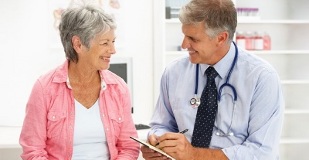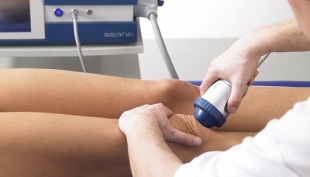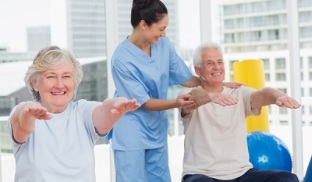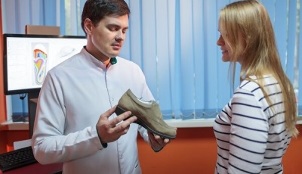
Arthrosis refers to damage to the joints and degenerative-dystrophic changes in them. This requires competent and timely treatment. The complex may consist of conservative methods or require surgical intervention.
Arthrosis is a chronic disease of degenerative-dystrophic nature. It involves the destruction of cartilage and pathological changes in the capsule, synovium, garden apparatus and adjacent bone structures. Requires an integrated approach to pathological treatment.
Medication
One of the main areas of conservative treatment of osteoarthritis is the use of drugs. The following medications are generally prescribed:
- Non-steroidal anti-inflammatory drugs. Eliminates inflammation, pain and fever.
- Glucocorticosteroids. These medications also relieve inflammation and pain, but are more effective.
- Pain medications. These include analgesics and some NSAIDs.
- Chondroprotectors. Such drugs are used in long courses. Needed for the restoration of affected cartilaginous structures.
- Muscle relaxants and antispasmodics. These drugs also relieve pain by relieving muscle spasms.
- If osteoarthritis is the result of gout, anti-gout medications are needed.
- vasodilators. Such drugs have a vasodilating effect.
- Compresses are effective in the treatment of osteoarthritis using medical bile and other means.
- Vitamin and mineral complexes. Needed to activate immunity, normalize metabolism and metabolic processes, replenish missing elements and assimilate them. Calcium supplements are generally prescribed.
Individual medication choices are often wrong. The attending physician should prescribe the medication and determine the characteristics of its use.
Physiotherapy
Various physiotherapy procedures are generally included in the treatment of osteoarthritis. It is used as part of conservative therapy and is prescribed postoperatively to speed recovery and reduce the risk of complications.
The following procedures are effective for osteoarthritis:

- laser therapy- exposure to heat to stimulate regeneration;
- magnetotherapy- increase vascular tone, activate metabolic processes, accelerate healing, eliminate inflammation;
- ozokeritotherapy- warming to improve microcirculation and reduce pain;
- electrophoresis- taking drugs by electric current;
- cryotherapy- exposure to low temperatures to reduce swelling, pain, muscle tone;
- ultrasound- exposure to high frequency sound to improve material exchange;
- UHF therapy- softening of calcium deposits, normalization of metabolism, reduction of edema;
- homeosiniatry- bringing homeopathic remedies to biologically active points.
There are contraindications to physiotherapy procedures. These include exacerbation of the inflammatory process, pregnancy, active tuberculosis. There are also a number of restrictions for individual procedures.
Massage
Massage is used in remission of osteoarthritis or in the subacute period. In acute disease, such treatment is excluded, because the affected joints need complete rest.
Massage for osteoarthritis provides the following effects:
- painkiller;
- return of mobility, removal of stiffness;
- activation of blood circulation and lymph flow;
- prevention of muscle atrophy, strengthening of the muscle corset;
- Improvement of metabolic processes and tissue trophism.
The characteristics of the massage depend on which joints are affected. In any case, such therapy should be carried out only by a qualified specialist. Before the massage, you should assess the degree of mobility, the condition of the muscles, determine the contractures, ankylosis, pain points.
The effectiveness of the massage is ensured by the application of the course. The number of sessions is determined individually. It is necessary to repeat massage courses periodically - their frequency is also selected individually.
exercise therapy
Physiotherapy is actively used for osteoarthritis. Needed to activate blood circulation and metabolic processes, restore joint mobility and strengthen the muscle corset. At the initial stage, the exercise therapist should be supervised by an instructor.
You can do home gymnastics in the future:

- Lie on your back on a firm surface and stretch your legs. Bend one leg at the knee and keep the leg 5-10 cm above the ground. In this position, straighten for 5 seconds, return to starting position. Repeat 5 times on each leg in turn.
- The starting position is the same. Bend one leg and press your hands to your body. Fix it in a few seconds. Then place your foot on the ground and slowly straighten the joint. Repeat 10-15 for each leg.
- The starting position is the same. Lift your straightened leg 25-30 cm off the ground and straighten for a few seconds. Return to starting position. Repeat 20-30 on each leg in turn.
- Lie on your stomach. Bend your knees in turn, try to reach your hips with your heels, but without lifting your hips off the ground. Repeat 20-50 for each leg.
- The starting position is the same. Bend your knees alternately, straightening yourself for a few seconds at the extreme point. Repeat 10 for each leg.
- Sit up and straighten your back. Alternatively, bend and flex your legs, maintaining a moderate speed. In the future, you can do sports with a small weight.
- The starting position is the same. Raise your foot to create a right angle. Adjust for 3 seconds and return to starting position. Repeat 10 for each leg.
Osteoarthritis can affect different joints, so the set of exercises should be specific to each situation. It should be prepared by a specialist, taking into account the individual characteristics of the patient and the disease.
All exercises should be performed smoothly, sharp movements are excluded. You need to watch your breath during gymnastics - it should be calm and measured.
Lifestyle
Treatment of osteoarthritis includes some lifestyle changes:
- If you are overweight, you need to normalize it. This moment is especially important in case of damage to the lower extremities.
- Moderate physical activity. High loads should be excluded, so you should not do professional sports. The best choice is physiotherapy exercises and regular walks.
- Take care of your health. Treatment of chronic diseases, regular intake of vitamin-mineral complexes, prophylactic examinations by a doctor are required.
- Choosing the right clothes and shoes. One should not be shy. Tight clothing is fraught with blood stasis, which is dangerous with osteoarthritis. Women should avoid high-heeled shoes, shoes should be stable.
- Proper organization of sleep and workplace. All furniture should be comfortable. The body must maintain such a position that does not slow down blood circulation and does not cause limb flow. If you have problems with movement, you should equip your home with special handles and handles.
Diet
With osteoarthritis, it is important to follow a proper diet. The characteristics of the diet depend on the individual and many factors.
The general principles of nutrition are as follows:
- Fractional nutrition. You need 5-6 meals a day and the portions should be small.
- Proper metabolism is ensured by a sufficient amount of carbohydrates. Attention should be paid to complex carbohydrates - vegetables, fruits, berries, cereals.
- Elimination of simple carbohydrates - sugar, sweets.
- Vegetable oils are needed to speed up metabolic processes. When it comes to butter, only a natural product is useful.
- To restore cartilage structures, it is useful to use gelatin-based mixed meat, jelly.
- To cook, you need to limit yourself to cooking, baking and steaming.
- Eliminate spicy, salty, fatty, fried foods from the diet. Avoid fatty meat, fast food, corn oil.
- The diet should be enriched with milk, cottage cheese, other dairy and fermented milk products. They should be lean or low-fat.
- You need foods rich in zinc and magnesium - liver, fish, nuts, pumpkin, legumes.
- Oranges and bell peppers are good sources of antioxidants. You should use pomegranate and pineapple to eliminate inflammation.
Special orthopedic devices
In the treatment of osteoarthritis, various devices are often used to facilitate the patient's life and reduce the risk of some complications.
The following constructions are used in orthopedics:

- Reed is used to redistribute the load when the lower extremities are damaged. It is generally used in the later stages of the disease, as well as after surgery.
- Orthoses - used to straighten joints. This allows you to gradually increase or decrease the movement of the joint.
- Bandages - also used to straighten joints, preferably after injuries and surgery.
- Corsets are mainly used to straighten and straighten the trunk in the position of the hip joints.
- Heel pads - provides cushioning, reduces the load.
- Linings to straighten and relax the legs.
- Correctors for deformed fingers.
- Silicone shields to protect deformed fingers.
If osteoarthritis is caused by flat feet, orthopedic shoes and special padding should be used. Such a measure is necessary in case of damage to the lower extremities to reduce the risk of complications.
Elongation of joints
This technique is called traction. It can be manual or hardware. Traction is commonly used when the hip or knee joints are affected.
Traction involves the application of a course. On average, 10-12 sessions are required. They can be performed daily or every day.
Joint expansion is a temporary measure and should be repeated from time to time. Osteoarthritis is usually treated twice a year.
Traditional medicine
The use of traditional medicine is appropriate as an adjunct to treatment.
The following recipes are effective for osteoarthritis:
- Squeezed with cabbage or horseradish leaves. The selected layer should be washed or chopped in several places, applied to the affected area, covered with foil and insulated. It is also effective to pre-immerse the leaves in puppies. Such a compress should be kept for several hours and applied several times a day.
- Mix iodine (5%), ammonia (10%), medical bile, glycerin and yeast in equal parts. Mix the ingredients and put in a dark place for a week and a half. Shake the mixture before use and heat the required volume in a water bath. Moisten a napkin in the composition, apply to the affected area, cover with cellophane and insulate. Apply a compress overnight.
- Pour 50 g of dried elecampane root in half a glass of vodka and keep in the dark for 2 weeks. Rub the painful joints with the resulting product.
- Powder the eggshell, mix with kefir, make a thick mixture. Bend the canvas and glue it to the affected area, line it with polyethylene and reinforce. Prepare a compress every day and keep for 2, 5 hours.
- Mix equal parts of honey with glycerin, alcohol and iodine. Apply the mixture gently with a cotton pad, moving from bottom to top.
- Pour a handful of rolled oats with half a liter of water and boil for 10 minutes. Apply warm to the affected area, cover with foil and insulate. Wait an hour.
Natural medicines also have contraindications and side effects. Each new product should be used with caution, starting with the minimum dose and duration of use.
Surgical Treatment
Surgery is needed in case of serious pathological changes, development of serious complications and ineffectiveness of a conservative approach.
Surgical treatment of osteoarthritis can be performed in the following ways:
- Arthroplasty- restoration of joint surfaces. An indication may be ankylosis, contracture. Such an operation is possible only in the absence of an acute inflammatory process.
- Arthrotomy- opening of a joint to remove a foreign body, endoprosthetic, purulent contents.
- Arthrodesis- ankylosis (joint immobility) is artificially created. The operation can be intra- or extra-articular.
- Resection- partial or complete removal of the joint surface and synovium to create immobility in the joint.
- Arthrorisis- create conditions to limit joint mobility.
- Endoprosthetic- implant placement for complete or partial replacement of the affected joint.
- Periarticular osteotomy- filling the bones and exposing them at a certain angle. This measure allows you to change the center of gravity and redistribute the load.
Arthrosis is a serious disease that causes irreversible changes. Adequate treatment should be started as early as possible. It can be conservative or surgical and involves a number of different measures. The characteristics of the therapy are determined individually for each patient.

















































